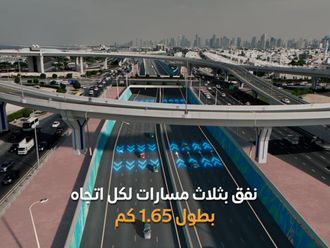Dubai: Sensors and high-tech cameras will be increasingly used to check if a driving licence applicant will pass or fail in Dubai.
The system will test manoeuvres and driver’s response, thanks to sophisticated cameras linked to a central processor capable of quickly capturing all data.
Errors are then automatically computed, allowing the system to judge if the applicant has passed — or failed.
The facility, called Smart Training and Testing Yard, was launched at the Dubai Driving Center, Al Quoz by Mattar Al Tayer, Director-General and Chairman of the Board of Executive Directors of the Roads and Transport Authority (RTA).
Expansion plan
According to the expansion plan of smart yards, which started with two yards last February, the number will rise to as much as 16 smart testing yards by the last quarter of this year.
Al Tayer was briefed about the system used in the smart yards for testing drivers with the aim of ensuring transparency and reducing human errors by relying on a smart system free from examiner’s intervention.
The briefing explained the increased efficiency of testing operation through the automated operation, improved safety through using technologies to fend off accidents, and nurturing competent personnel to work in a smart environment.
The system can provide a personalised driving experience to increase the efficiency of trainees, and accelerate the turnover of yard testing procedures.
Accordingly, it increases the intake of trainees subjected to test, saves human resources, increases the testing rates by 72%, and reduces the operational cost.
The Smart Testing Yard is fitted with a control tower enabling the examiner to monitor multiple vehicles at a time.
A log of all testing stages will be saved to ensure fairness in assessing the test result; which can be retrieved upon request.
HE Mattar Al Tayer launched Smart Testing Yard at Dubai Driving Center. For more details, visit: https://t.co/OuTQlDLinJ#SmartCity pic.twitter.com/bfGn9YaU3c
— RTA (@RTA_Dubai) March 24, 2018
Vehicles are fitted with a tablet, central processing unit, and five internal, front, back and side cameras.
They are also fitted with sensors to identify the face, sensors in the steering wheel, brake, engine and collision.
Cameras, sensors
To enhance the smart testing system, the testing yard is provided with special signs for the vehicle to identify the five manoeuvring areas once it passes across them, thanks to the side cameras fitted to the vehicle.
Images and details are then transmitted through ground sensors to the advanced processor to work out the result.
Through the tablet, it will be possible to explain the required manoeuvres using voice messages during the test.
As for safety and security, vehicles are fitted with a safety system considered the first of its kind worldwide.
The vehicle can come to a complete halt in case the speed exceeds 35 km/h, or if it approaches an object to the front of a vehicle driving at a speed of 20 km/h, or in the event of crashing into an obstacle to the front.
According to the expansion plan of the Testing Yard, which has started with two yards last February in Dubai Driving Center at Al Quoz and Belhasa Driving Center at Al Quoz, two new yards will be delivered at the Emirates Driving Institute at Al Qusais, and Galadari Driving Center at Al Quoz.
In May, four new testing yards will be added to Belhasa Institute at Jebel Ali, Dubai International Driving Center, Al Ahali Driving Institute at Al Quoz and Al Ahli Driving Institute at Jebel Ali.
In September, eight yards will be added to Galadari Driving Center at Al Qusais, Dubai Driving Center at Al Qusais, Belhasa Driving Institute at Al Wasl, Belhasa Driving Institute at Nad Al Hamar, Emirates Driving Institute at Al Quoz, Emirates Driving Institute at Rashid Port, Dubai Driving Center at Jumeirah, and Emirates Transport Driving Institute at Warsan.












